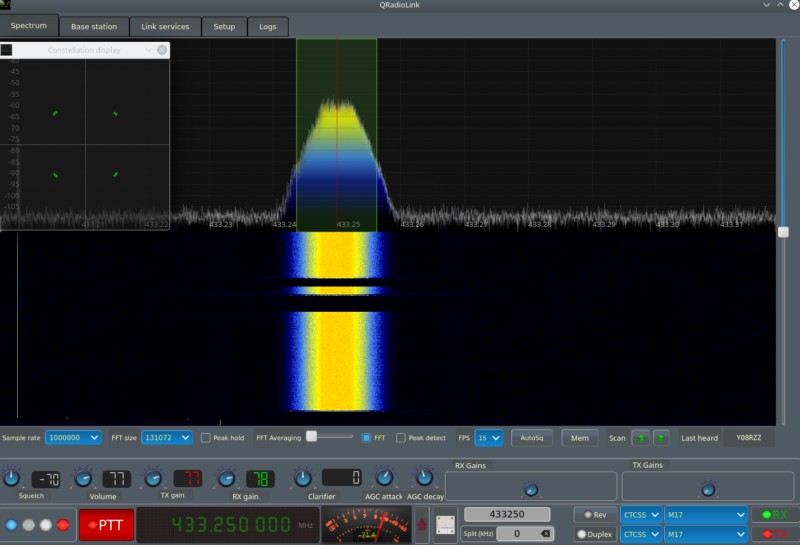
QRadioLink is a GNU/Linux multimode (analog and digital) SDR (software defined radio) transceiver application using the Internet for radio to VOIP bridging (radio over IP), built on top of GNU radio, which allows experimenting with software defined radio hardware using different digital and analog radio signals and a Qt5 user interface.
Possible usages:
- Experimentation, hobby and amateur radio applications
- Educational (low cost, low complexity, low reliability research platform into: radio communications, digital voice and data radio applications, voice call routing)
- It should NOT be used in mission critical communications, industrial applications, other applications where data integrity is important.
Features
- UDP audio streaming for both transmit and receive
- Interoperability with SVXlink via UDP audio
- Multicast radio to VOIP bridge (Radio-over-IP) connection between two or more endpoints operating in simplex or semi-duplex mode. The VOIP bridge uses a star topology with a central application (umurmur) acting as voice packet router and providing logical channel separation.
- Direct VOIP talk-around (only requires connection to a VOIP server and no radio)
- Radio forwarding over VOIP – forward analog or digital radio voice to VOIP connection and viceversa
- Wideband audio streaming over the Internet using the Opus audio codec
- Configurable VOIP bitrate
- MMDVM base station mode with TDMA support (DMR, System Fusion, D-Star, M17) using LimeSDR devices
- ETSI compliant DMR base station (repeater) supporting double timeslot TDMA with LimeSDR family devices and MMDVM-SDR.
- Multi-channel / multi-carrier MMDVM system using LimeSDR devices. Up to 7 carriers supported in 200 kHz bandwidth, duplex mode. Number of channels can be configured between 2 and 7. Channel separation configurable to 12.5 or 25 kHz.
- M17 digital voice modulator and demodulator
- Audio recording for local audio output in FLAC (free lossless audio compression) format
- Compatible with the Mumble client application
- Remote control via network (requires a telnet client or similar program, can be scripted)
- Remote control via Mumble private text messages
- Run headless (no graphical user interface) for terminal usage on embedded platforms like the Raspberry Pi or similar boards without any screen
- Transmit and receive analog FM, SSB, AM, digital voice, text messages, digital video, IP protocol.
- Full duplex DQPSK 250 kbit/s and 4FSK 100 kbit/s IP radio modems with configurable TX/RX offsets
- Analog and digital mode repeater – in full duplex mode only, same mode or mixed mode repeater (e.g. FM to Codec2 and viceversa, or FM to Opus and viceversa)
- Radio node linking via VOIP and Mumble protocol – a group of radio nodes can be linked by sharing the same logical Mumble channel. Advantages of using the Mumble VOIP protocol include: multicast full-duplex voice transmission, no call setup overhead after initial network connection, simplicity of implementation, user defined logical channels, free software and open standard. This feature is still undergoing development.
- Full duplex and simplex operation
- Fast tune reverse repeater shift using dedicated button
- Split operation (transmit on other frequency than the receive frequency with no shift limitation, used mostly for repeater operation)
- Memory channels (store frequency, name, TX shift, operating mode, squelch value, volume, TX power, RX gain, TX and RX CTCSS) and memory channel scan
- Mixed mode operation (receive one mode and transmit another)
- Digital voice codecs: Codec2 700 bit/s, Codec2 1400 bit/s, Opus 9400 bit/s
- Digital voice modem bitrates over the air from 1 kbit/s to 10 kbit/s
- FreeDV digital voice modulator and demodulator (currently supports only 1600, 700C, 700D and 800XA modes)
- Wideband digital voice streaming over the Internet with the Opus audio codec
- Digital modulation: M17 digital mode, FreeDV 1600, FreeDV 700C, FreeDV 700D, FreeDV 800XA, BPSK, DQPSK, 2FSK, 4FSK
- Analog modulations: FM (12.5 kHz), narrow FM (6.25 kHz), SSB, AM, Wide FM (broadcast, receive-only)
- Simple, low resolution video mode (JPEG encoded) operating at 10 frames per second in 300 kHz bandwidth, now with sound using the Opus codec at 9400 kbit/s
- Configurable filter widths for analog modes (AM, FM, SSB)
- CTCSS encoder and decoder for analog FM
- VOX mode with configurable VOX level
- USB FTDI (FT232) relay control support (for RF switches, power amplifier and filter control). Boards with up to 8 relays are supported.
- Automatic carrier tracking and Doppler effect correction. The system can track Doppler shifts of up to 5-10 kHz, depending on mode. It requires a CNR of at least 10-12 dB, more for FSK modes than for PSK modes.
- Supported SDR hardware: Ettus USRP bus devices, RTL-SDR, ADALM-Pluto (PlutoSDR), LimeSDR-mini, LimeNET-Micro, BladeRF, other devices supported by gr-osmosdr (HackRF, RedPitaya, others not tested)
- Support for the LimeRFE RF frontend.Only amateur radio bands are supported. Cellular paths for LimeRFE boards which have them are not supported. Automatic tuning of the frontend works according to IARU region 1 bandplans.
Note: QRadioLink uses code from the gr-cessb GNU radio out of tree module. Since this module is not packaged by some distributions, the code is included in the application.
